Shore Diving Sites in New Jersey
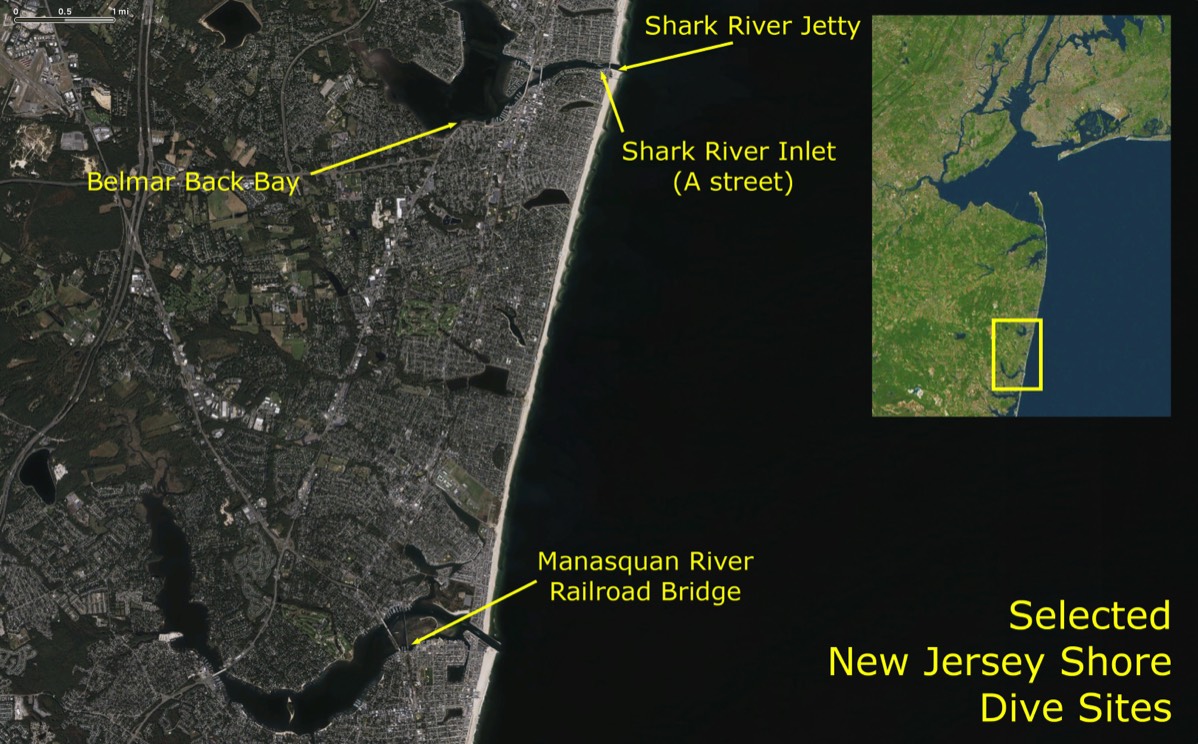
MANASQUAN RIVER RAILROAD BRIDGE
The railroad bridge is my favorite dive in this area –plentiful sea life, an easy entry, convenient parking, the lack of time restrictions or boat traffic, and the fact that there is not much risk of getting swept downriver or out to sea.
The site is in the Gull Island County Park, on the south shore of the Manasquan river, in the town of Point Pleasant. The land seen looking north across the water is Gull Island, a conservation area. Past that is the rest of the river and the north shore in Brielle, but diving is confined to the area near the bridge and to the immediate east of it, downriver.
There is a parking lot reserved for anyone using the Gull Island county park, right next to Spike’s restaurant (a great place for a post-dive meal). You can also street park on Broadway, which is even closer to the entry point. There is no public bathroom at the site, but there usually is a porta-potty. The site is open to diving year-round, 24/7.
There is a gear table next to the parking lot, or you can gear up right at the seawall – it’s at a good height for donning your rig. Entry is an easy stroll down a ramp to a little beach on the east side of the south end of the bridge. Get in the water, then watch the current and slip down the bank to the site once it has reasonably slowed – slack tide is often 30-40 minutes after the published high tide. You can estimate the flow by watching the water ripple around the bridge.
While knowing the tides is important for all inlet diving, getting caught in an outgoing tide here is not as much of a problem as it might be elsewhere. The water widens east of the bridge, which means that the flow drops off. Also, you are fairly far from the ocean. If necessary, you can just swim south and make it back to the entry point by “walking” along the wall.
Most of the sea life is right under the bridge. But people also dive in the wider area to the east of the site, where there are larger fish, attracting spearhunters on scuba or freediving. If you go through the bridge piles and keep swimming west, you will be heading towards the marina - don’t do this. Stay away from the docks, and stick to the area close to the bridge. There is virtually no boat traffic near it, apart from the occasional kayak.
There is a lot of biodiversity here, with blennies making territorial homes in cans, pipes and other secure spots – these are commonly seen on the river bank to the north of the bridge on the western (marina) side. Toadfish are found in the dense mussel beds under the bridge. Schools of northern puffers coast over the shoals, and you can see horseshoe crabs, skates, eel, lobsters, flounder and juvenile cunner. In late season, butterflyfish are often in the slope just off the entry point.
As mentioned above, the current at this site really picks up as you stay longer and longer past slack tide. I find this to be a great time to dive. While it’s harder to anchor yourself for photography, letting the current carry you under the bridge, superman style, is a lot of fun. If you don’t mind crawling back upcurrent, you can swim south to the shallows, head back west to the bridge, pull yourself through, and take the ride again. And occasionally you will be in the water as a train goes over the bridge – another exciting part of the dive, as you hear and feel the thundering above.
The railroad bridge is my favorite dive in this area –plentiful sea life, an easy entry, convenient parking, the lack of time restrictions or boat traffic, and the fact that there is not much risk of getting swept downriver or out to sea.
The site is in the Gull Island County Park, on the south shore of the Manasquan river, in the town of Point Pleasant. The land seen looking north across the water is Gull Island, a conservation area. Past that is the rest of the river and the north shore in Brielle, but diving is confined to the area near the bridge and to the immediate east of it, downriver.
There is a parking lot reserved for anyone using the Gull Island county park, right next to Spike’s restaurant (a great place for a post-dive meal). You can also street park on Broadway, which is even closer to the entry point. There is no public bathroom at the site, but there usually is a porta-potty. The site is open to diving year-round, 24/7.
There is a gear table next to the parking lot, or you can gear up right at the seawall – it’s at a good height for donning your rig. Entry is an easy stroll down a ramp to a little beach on the east side of the south end of the bridge. Get in the water, then watch the current and slip down the bank to the site once it has reasonably slowed – slack tide is often 30-40 minutes after the published high tide. You can estimate the flow by watching the water ripple around the bridge.
While knowing the tides is important for all inlet diving, getting caught in an outgoing tide here is not as much of a problem as it might be elsewhere. The water widens east of the bridge, which means that the flow drops off. Also, you are fairly far from the ocean. If necessary, you can just swim south and make it back to the entry point by “walking” along the wall.
Most of the sea life is right under the bridge. But people also dive in the wider area to the east of the site, where there are larger fish, attracting spearhunters on scuba or freediving. If you go through the bridge piles and keep swimming west, you will be heading towards the marina - don’t do this. Stay away from the docks, and stick to the area close to the bridge. There is virtually no boat traffic near it, apart from the occasional kayak.
There is a lot of biodiversity here, with blennies making territorial homes in cans, pipes and other secure spots – these are commonly seen on the river bank to the north of the bridge on the western (marina) side. Toadfish are found in the dense mussel beds under the bridge. Schools of northern puffers coast over the shoals, and you can see horseshoe crabs, skates, eel, lobsters, flounder and juvenile cunner. In late season, butterflyfish are often in the slope just off the entry point.
As mentioned above, the current at this site really picks up as you stay longer and longer past slack tide. I find this to be a great time to dive. While it’s harder to anchor yourself for photography, letting the current carry you under the bridge, superman style, is a lot of fun. If you don’t mind crawling back upcurrent, you can swim south to the shallows, head back west to the bridge, pull yourself through, and take the ride again. And occasionally you will be in the water as a train goes over the bridge – another exciting part of the dive, as you hear and feel the thundering above.

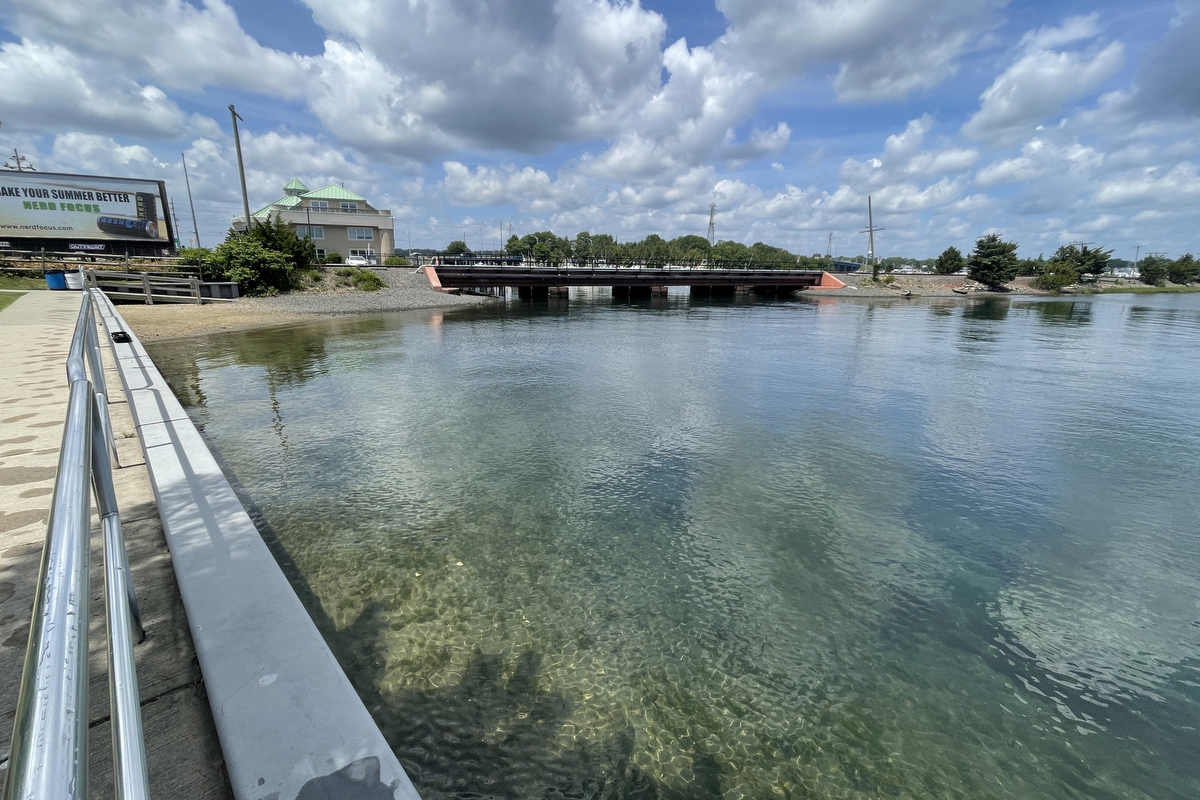


.
.
Note: Slack tide at the bridge is around 30-40 minutes after the published high tide
BELMAR BACK BAY
This very wide portion of a tidal estuary between Belmar and Avon-by-the-Sea. The dive site is mainly the shallow water near the southern seawall, where seahorses and other small critters may be found in 6 feet of water. However, swimming north towards the center of the channel will get you more depth (around 15 feet) and bigger fish. There are no mussel beds or other riverbed structure like you find on the bridge, which means a lot less sea life. Nevertheless, if you look in the fringes of the sea grass on the sandy bottom or along the wall, you may find some interesting fish and crabs.
The entrance to the dive site is down a set of wooden stairs (installed by the town for divers) in a public facility called Maclearie Park. There is a gearing bench for divers, similar to the one at the Railroad bridge. Maclearie can get pretty crowded on a nice summer weekend, since the town also provides picnic tables and grills. There are bathrooms, tennis courts and a playground.
Because the Back Bay is so wide, the current is usually negligible. Nevertheless, getting in around high tide is recommended, just because most of the site is so shallow. Also, the water tends to be clearer at high tide, due to the influx of relatively clean ocean water. The site is open to diving year-round, 24/7.
This very wide portion of a tidal estuary between Belmar and Avon-by-the-Sea. The dive site is mainly the shallow water near the southern seawall, where seahorses and other small critters may be found in 6 feet of water. However, swimming north towards the center of the channel will get you more depth (around 15 feet) and bigger fish. There are no mussel beds or other riverbed structure like you find on the bridge, which means a lot less sea life. Nevertheless, if you look in the fringes of the sea grass on the sandy bottom or along the wall, you may find some interesting fish and crabs.
The entrance to the dive site is down a set of wooden stairs (installed by the town for divers) in a public facility called Maclearie Park. There is a gearing bench for divers, similar to the one at the Railroad bridge. Maclearie can get pretty crowded on a nice summer weekend, since the town also provides picnic tables and grills. There are bathrooms, tennis courts and a playground.
Because the Back Bay is so wide, the current is usually negligible. Nevertheless, getting in around high tide is recommended, just because most of the site is so shallow. Also, the water tends to be clearer at high tide, due to the influx of relatively clean ocean water. The site is open to diving year-round, 24/7.
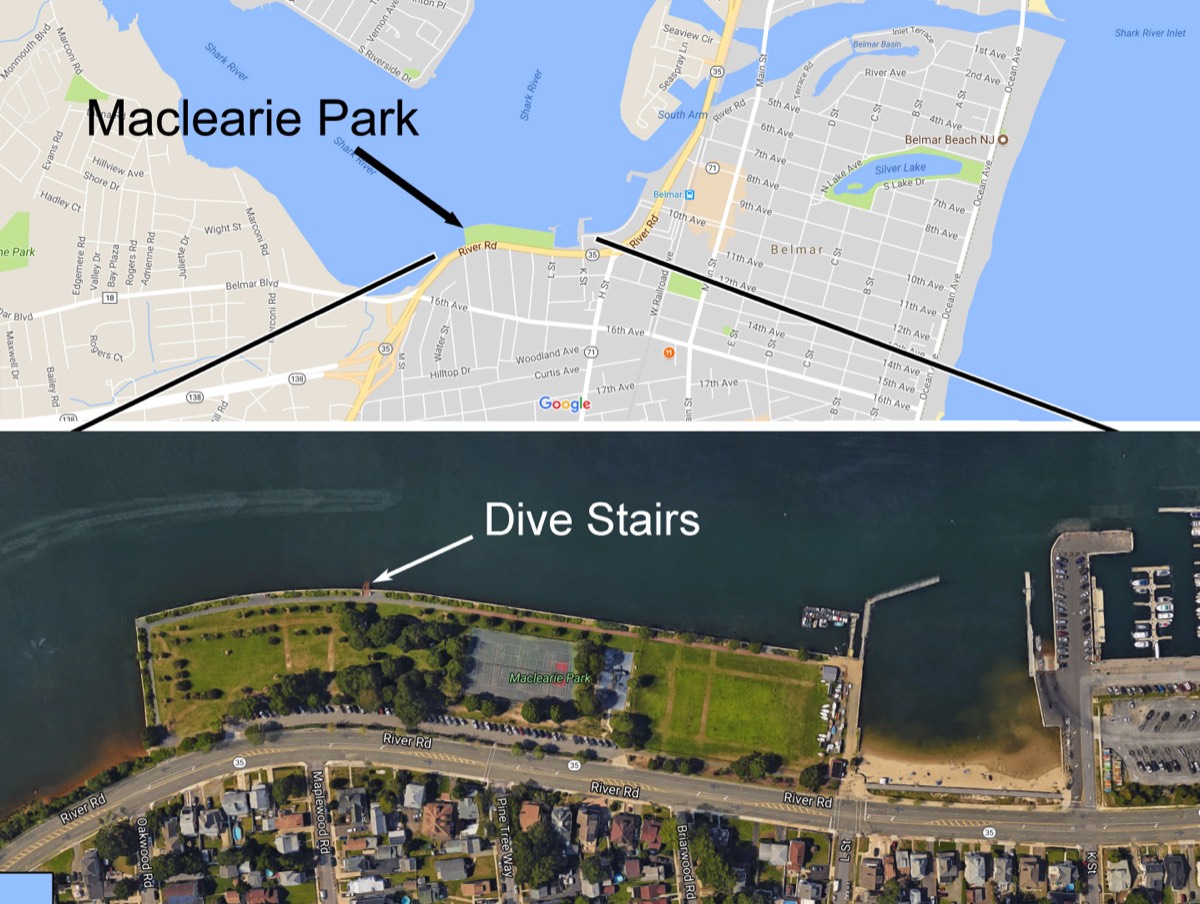
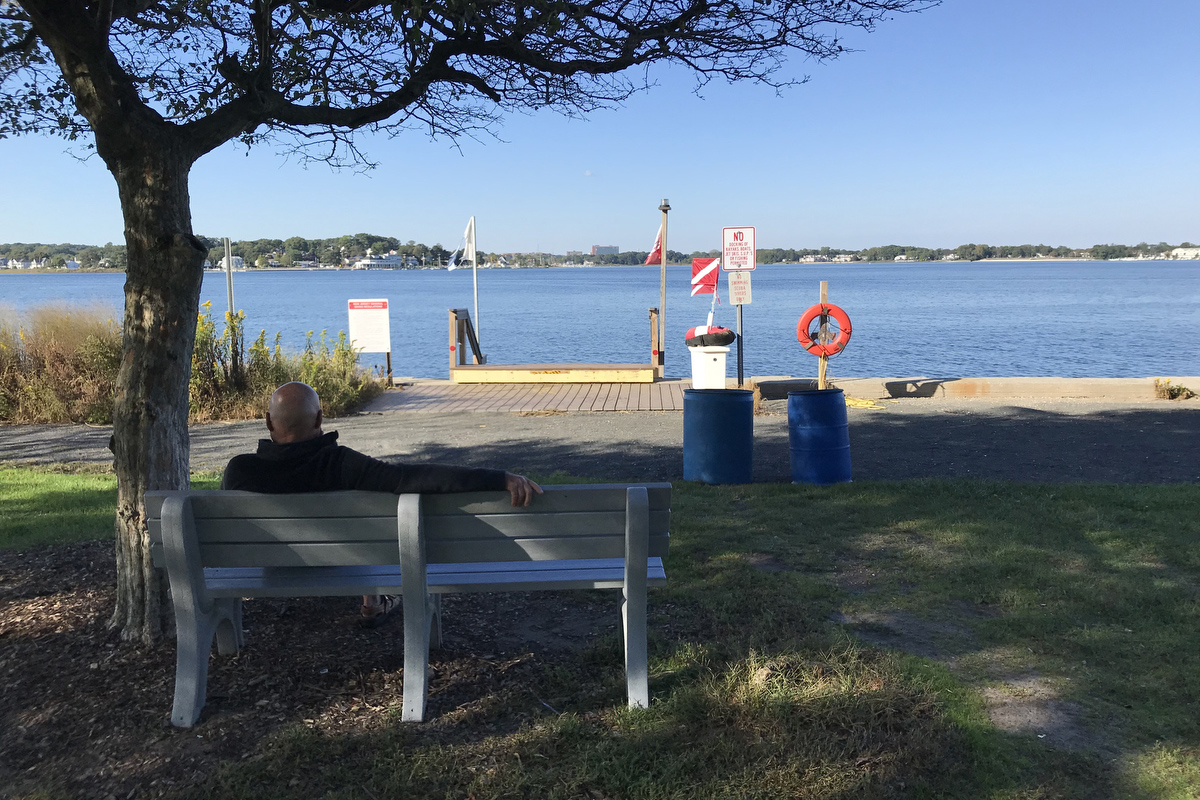
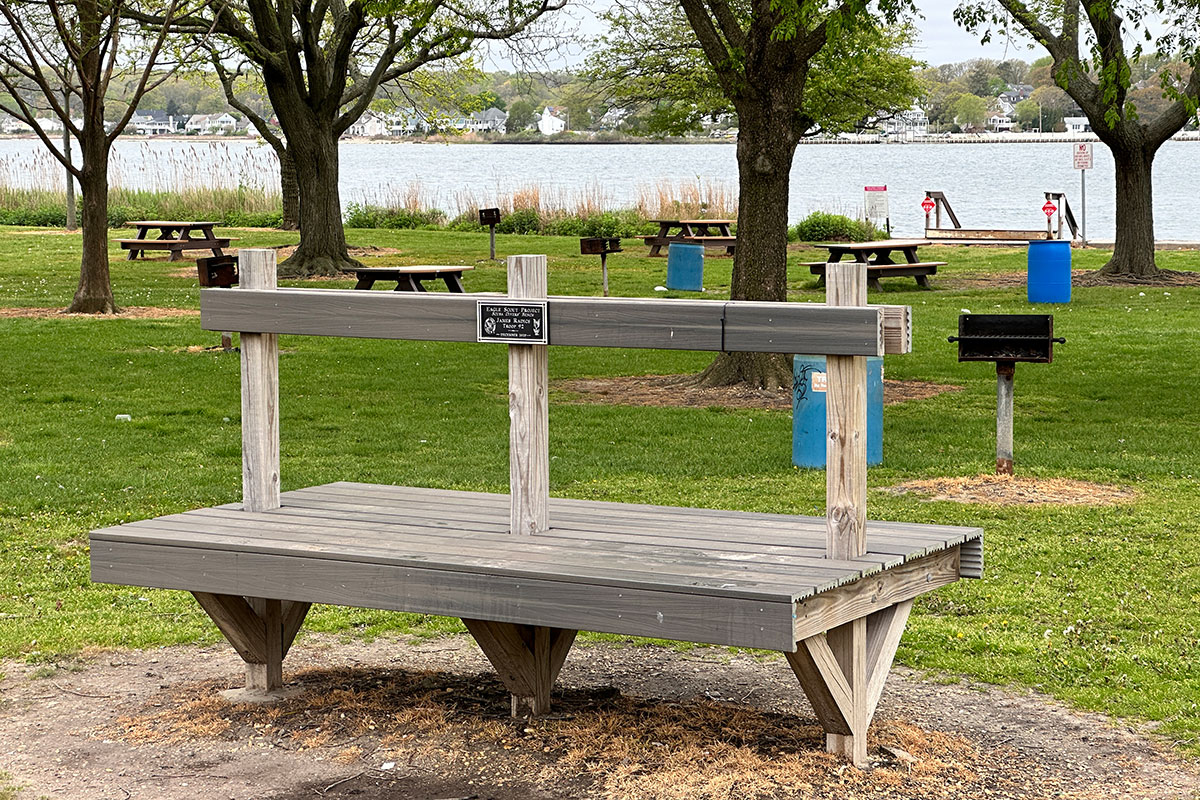
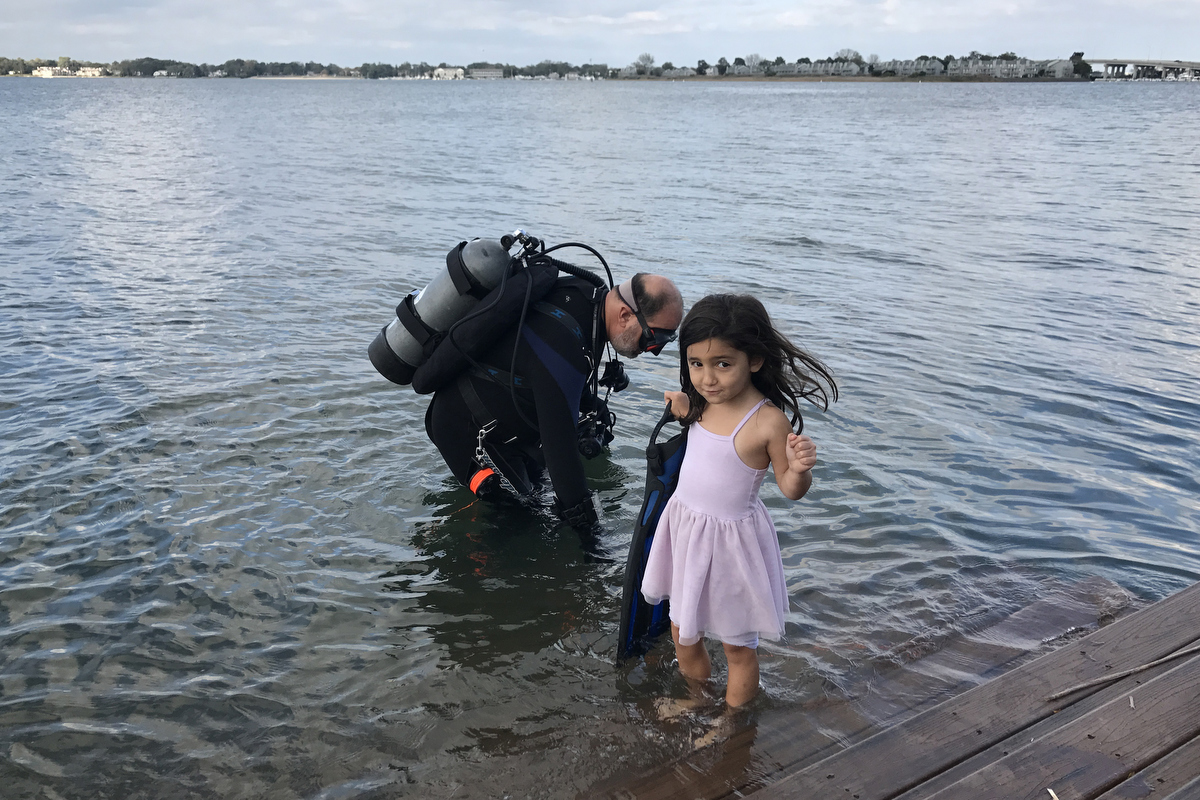
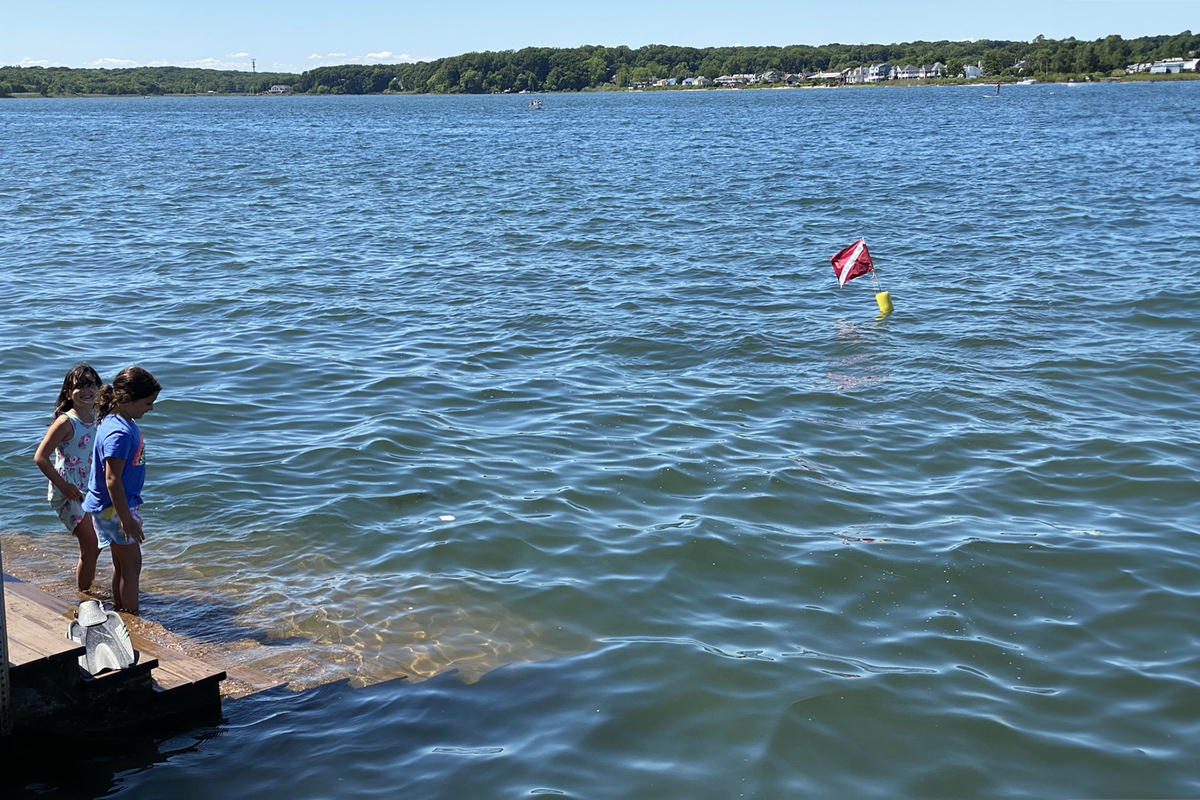
.
.
Note: The "New Bedford" tide station is named for a neighborhood in Belmar that corresponds to the Back Bay
A STREET IN BELMAR
Heading east from the Back Bay, the next dive site is a stretch on the south shore of the Shark River inlet, with an entrance/exit point where A street turns at the water. Parking is more limited here, and on a popular dive or fishing day, you may need to park a block or two away. The entry is more difficult here than at the bridge or the Back Bay, although the town has created a concrete ramp leading from the road down to the large boulders that line this waterway. Once at the end of the ramp, you climb down onto the rocks and enter the water. This can be challenging if you are carrying heavy gear like a camera. Carry your fins in your hand and put them on in the water or when sitting at the edge - it’s not a good idea to try to walk in them.
I usually just drop to the bottom here at around 15 feet and swim east, hugging the rocks along the shore, staying out of the main channel. The current can be much more of an issue here, you don’t want to be caught far away from the entry/exit point when the tide turns. Get in the water about 20-30 minutes before high slack tide, and start swimming east into the incoming water. When you feel the current stopping, that’s a good time to turn your dive and head back, again facing into the water flow. By planning your dive around high slack, you won’t have long swims in very heavy current to deal with. Usually, your turning point will be just before the Ocean Avenue bridge.
You typically see bigger fish here than at the Back Bay or the railroad bridge, due to the proximity of the ocean. There is a small protected area just west of A street on the south shore of the river, behind the pilings near the apartment complex seawall. I find that you can sometimes extend your dive a bit after you have returned to the entry/exit point if you still have gas, as it is shielded from the current. Don’t venture too far from the exit point in the face of an outgoing tide.
There can be a good deal of large boat traffic in this area. For this reason, diving is prohibited between 8:00 AM and 5:30 PM, between May 1st and October 1st. But even when diving is allowed, be aware that big boats can show up at any time.
Heading east from the Back Bay, the next dive site is a stretch on the south shore of the Shark River inlet, with an entrance/exit point where A street turns at the water. Parking is more limited here, and on a popular dive or fishing day, you may need to park a block or two away. The entry is more difficult here than at the bridge or the Back Bay, although the town has created a concrete ramp leading from the road down to the large boulders that line this waterway. Once at the end of the ramp, you climb down onto the rocks and enter the water. This can be challenging if you are carrying heavy gear like a camera. Carry your fins in your hand and put them on in the water or when sitting at the edge - it’s not a good idea to try to walk in them.
I usually just drop to the bottom here at around 15 feet and swim east, hugging the rocks along the shore, staying out of the main channel. The current can be much more of an issue here, you don’t want to be caught far away from the entry/exit point when the tide turns. Get in the water about 20-30 minutes before high slack tide, and start swimming east into the incoming water. When you feel the current stopping, that’s a good time to turn your dive and head back, again facing into the water flow. By planning your dive around high slack, you won’t have long swims in very heavy current to deal with. Usually, your turning point will be just before the Ocean Avenue bridge.
You typically see bigger fish here than at the Back Bay or the railroad bridge, due to the proximity of the ocean. There is a small protected area just west of A street on the south shore of the river, behind the pilings near the apartment complex seawall. I find that you can sometimes extend your dive a bit after you have returned to the entry/exit point if you still have gas, as it is shielded from the current. Don’t venture too far from the exit point in the face of an outgoing tide.
There can be a good deal of large boat traffic in this area. For this reason, diving is prohibited between 8:00 AM and 5:30 PM, between May 1st and October 1st. But even when diving is allowed, be aware that big boats can show up at any time.
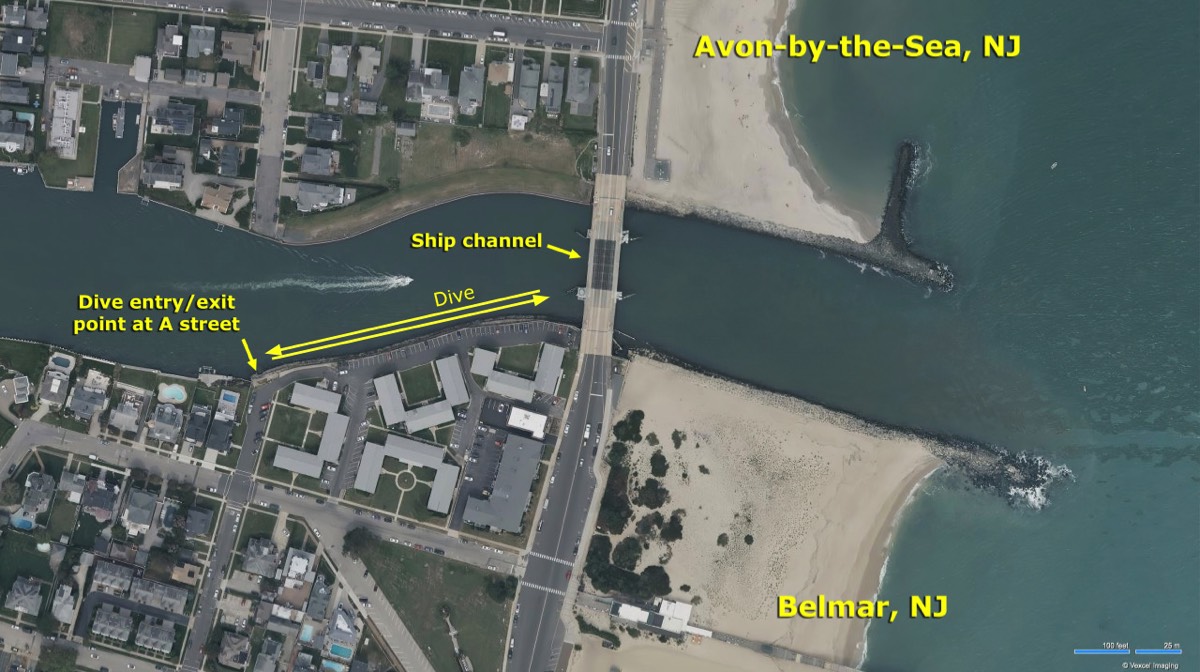
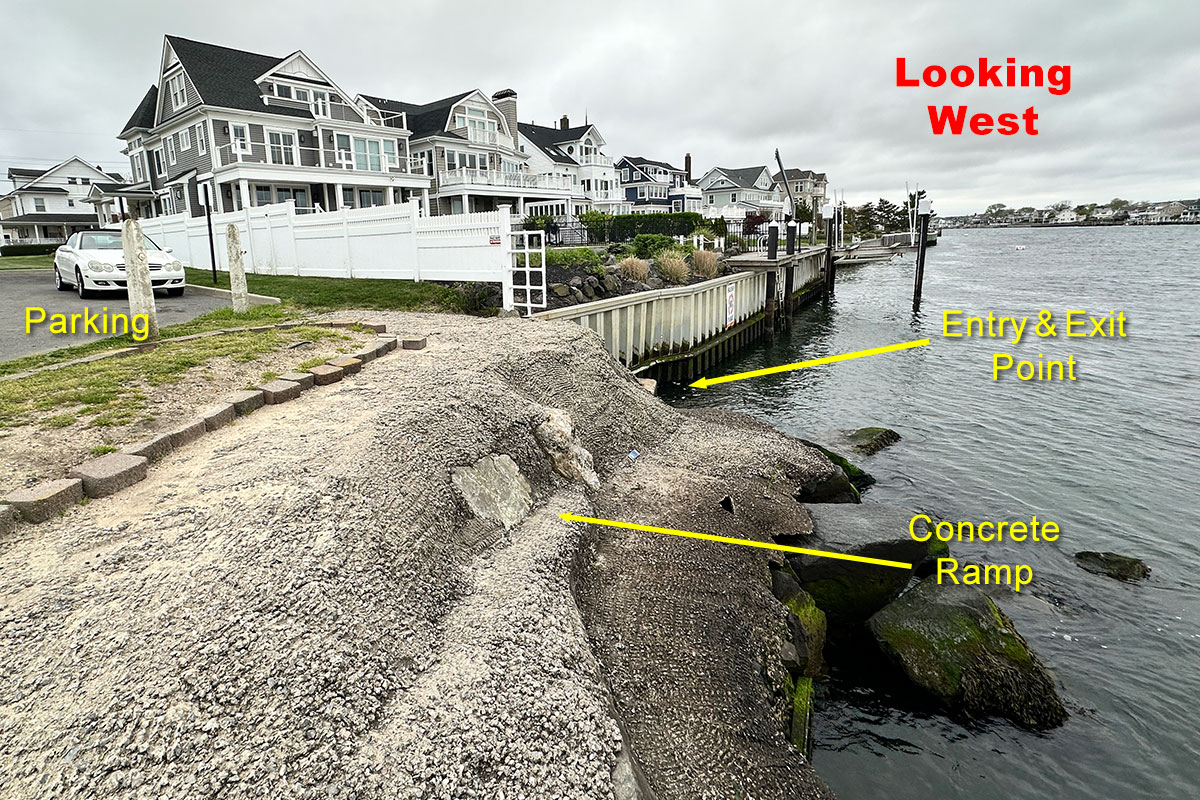

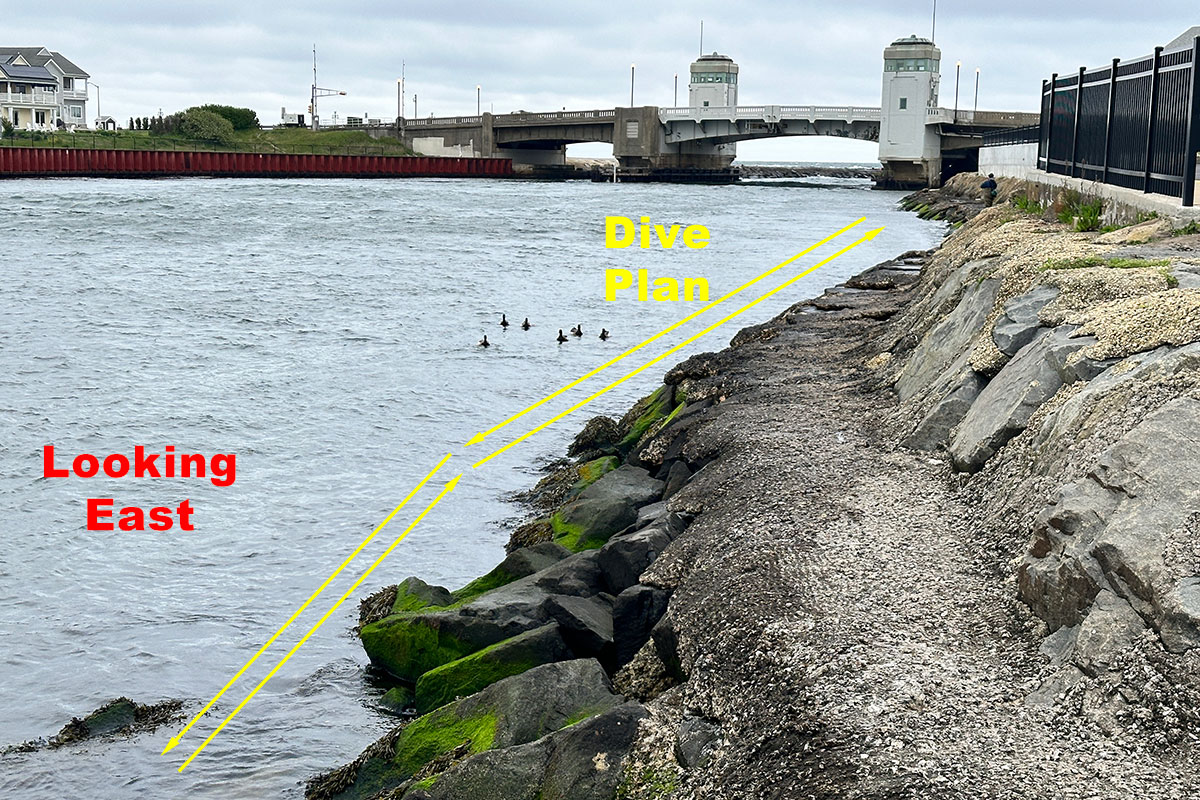
BELMAR JETTY
To get even further out (and to potentially see bigger sea life), you can also dive on the east side of the Ocean Avenue bridge. The entry here is by way of the beach, and you have to scramble down the large boulders near the bridge abutment. This is one of the more difficult entries in the area, and there are also likely to be people fishing on the jetty.
Again, this is a strong tidal dive, and miscalculating can end up with you being swept out into the ocean. Be sure to time your entry so that you can easily swim back to the exit point. Some very confident and strong divers will swim out to the end of the rocks, then go around the tip and swim back to the beach on the opposite side of the jetty.
Just like A street, hours are restricted between May 1st and October 1st (no diving from 8:00 AM to 5:30 PM).
To get even further out (and to potentially see bigger sea life), you can also dive on the east side of the Ocean Avenue bridge. The entry here is by way of the beach, and you have to scramble down the large boulders near the bridge abutment. This is one of the more difficult entries in the area, and there are also likely to be people fishing on the jetty.
Again, this is a strong tidal dive, and miscalculating can end up with you being swept out into the ocean. Be sure to time your entry so that you can easily swim back to the exit point. Some very confident and strong divers will swim out to the end of the rocks, then go around the tip and swim back to the beach on the opposite side of the jetty.
Just like A street, hours are restricted between May 1st and October 1st (no diving from 8:00 AM to 5:30 PM).

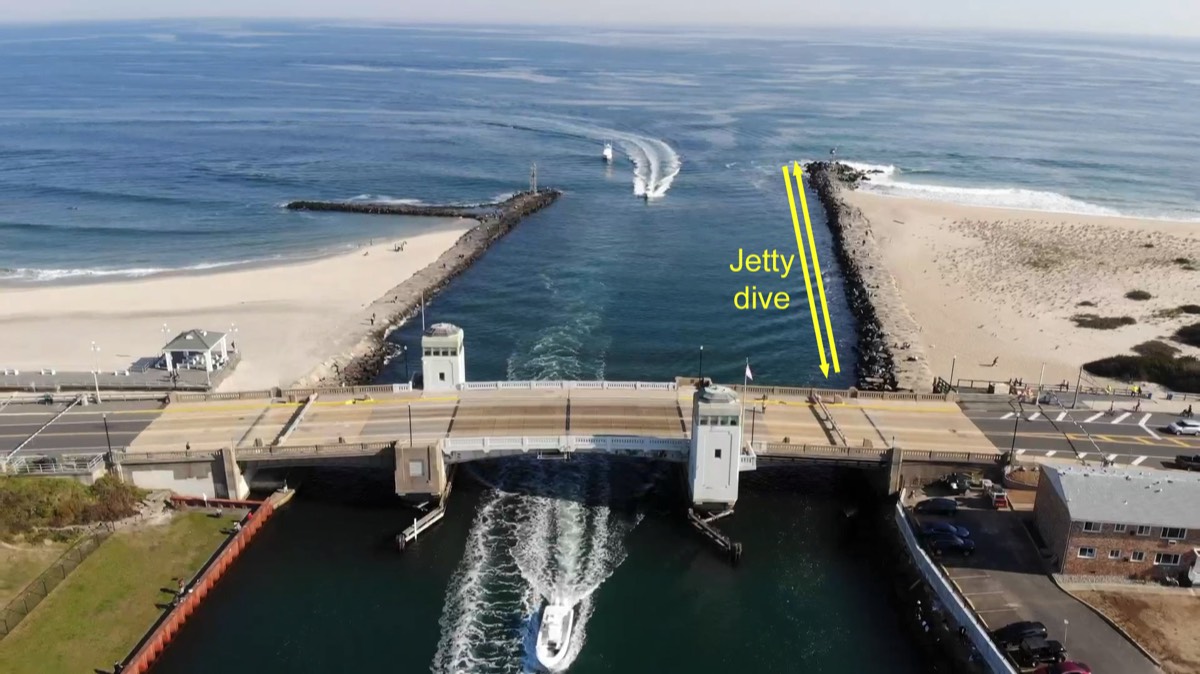
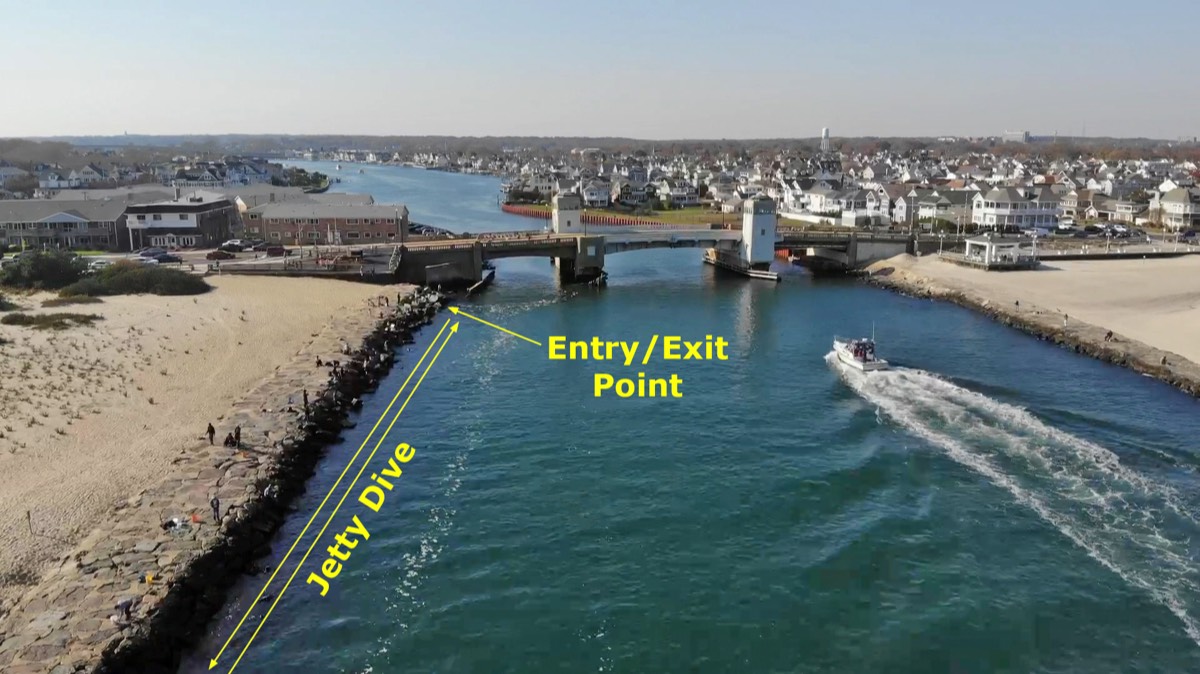
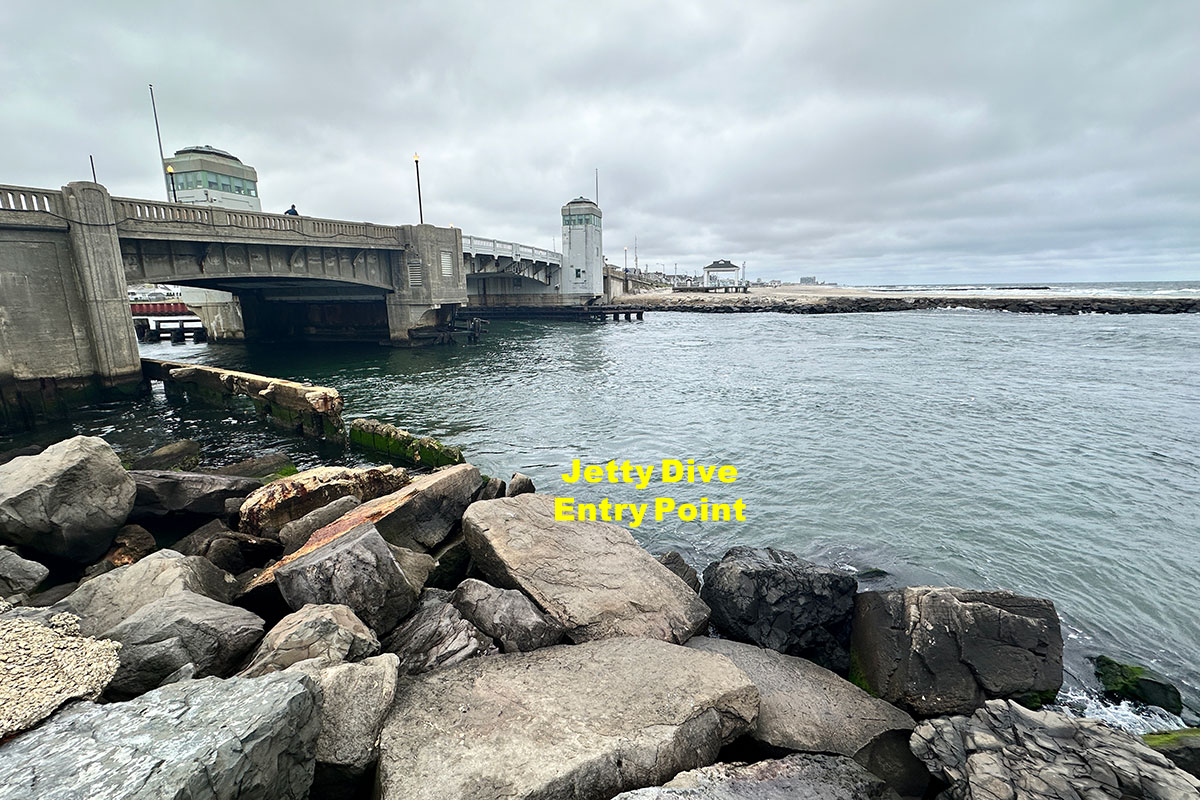

.
Note: The "Shark River Island" tide station is used for both A street and the Belmar Jetty
This website is meant to help divers who are new to diving in the New York City area to become familiar with the specific practices, culture, gear and conditions commonly encountered here. It is NOT meant to be a substitute for formal training and certification with an appropriate instructor and agency. Every diver is responsible for their own equipment, dive planning and safety.
